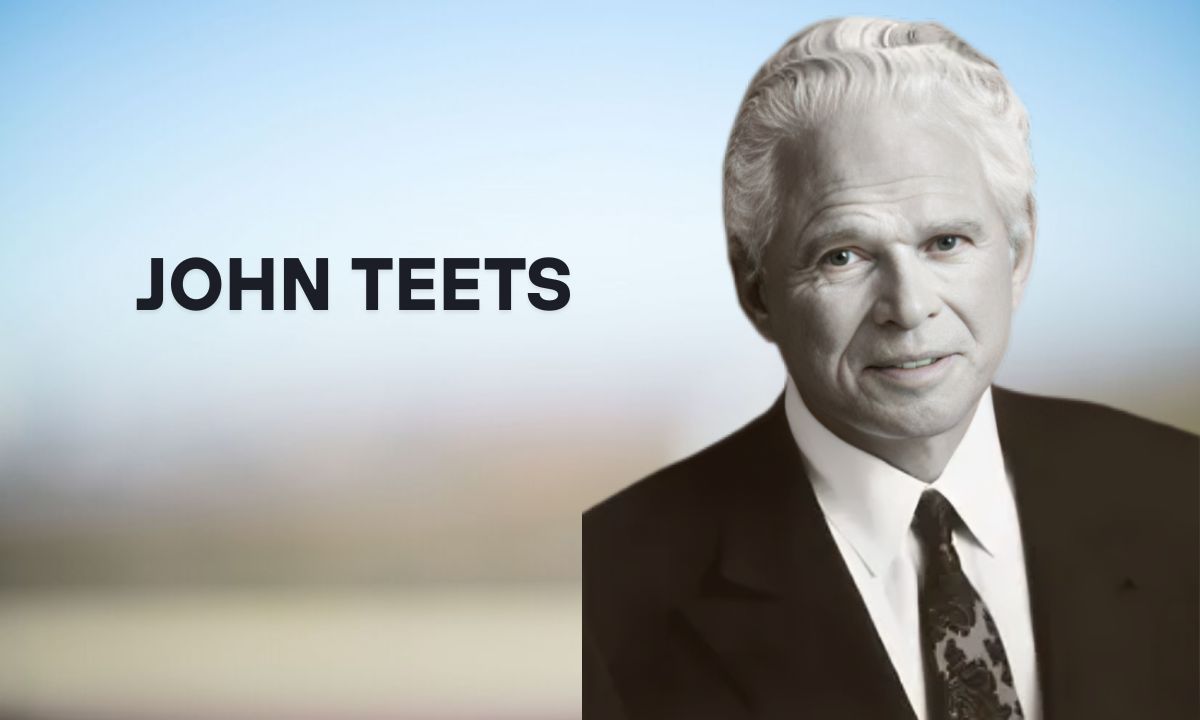In the pantheon of American corporate leaders, John Teets stands as a fascinating study of wealth creation through strategic business transformation. From humble beginnings to the pinnacle of corporate America, Teets’ financial journey offers valuable insights into how executive leadership translates to personal wealth. This comprehensive analysis explores John Teets’ net worth, examining the sources, growth, and ultimate legacy of his considerable fortune.
Quick Bio
John Walter Teets (1933-2011) transformed himself from a small-town Ohio native into one of America’s most influential business leaders. As the driving force behind both Greyhound Corporation and The Dial Corporation, Teets became known for his bold leadership style and unflinching approach to corporate restructuring.
During his prime in the 1980s and 1990s, he commanded respect in boardrooms nationwide while building a personal fortune that reflected his business acumen. His 78 years of life encapsulated the classic American success story—a testament to ambition, strategic thinking, and unwavering determination.
Who Was John Teets?
Born in Chillicothe, Ohio, John Teets emerged from modest circumstances to become a formidable figure in American business. His midwestern upbringing instilled values of hard work and pragmatism that would later define his management approach. While not born into wealth, Teets possessed natural business instincts that helped him rise through corporate ranks with remarkable speed.
Teets began his career in the hospitality industry, working with Greyhound’s food service division before making his way to the executive suite. Colleagues described him as intensely focused and occasionally intimidating—a leader who demanded results and wasn’t afraid to make difficult decisions. His reputation for straight talk and decisive action made him both respected and feared in corporate circles.
“I’m not in business to be loved. I’m in business to succeed.” — John Teets
His management philosophy centered on accountability and performance. Teets believed in stripping away corporate excess and focusing on profitable core operations—principles he applied throughout his tenure at both Greyhound and Dial. This results-oriented mindset not only rebuilt struggling companies but also substantially contributed to his personal wealth accumulation.
John Teets’ Net Worth Overview
At the time of his death in 2011, John Teets’ net worth was estimated at approximately $75-90 million—a considerable fortune that reflected decades of strategic business leadership. While not reaching the billionaire status of some contemporaries, Teets’ wealth placed him firmly among the business elite of his generation.
His financial value must be understood in the context of the era. During the 1980s and 1990s, executive compensation looked quite different than today’s astronomical packages. Teets built his wealth through a combination of salary, performance bonuses, stock appreciation, and personal investments—diversifying his fortune beyond just corporate compensation.
Net Worth Over the Years
Teets’ wealth trajectory closely mirrored his corporate ascension. His financial journey can be broken down into several key phases:
| Period | Role | Estimated Net Worth | Notable Wealth Factors |
| 1970s | Rising Executive | $1-5 million | Early stock options, executive salary |
| 1980-1985 | Greyhound CEO | $10-20 million | Increased compensation, initial restructuring success |
| 1986-1995 | Dial Corp Chairman | $30-60 million | Stock appreciation, merger benefits, investment growth |
| 1996-2005 | Post-retirement | $60-80 million | Investment returns, board positions, consulting |
| 2006-2011 | Later years | $75-90 million | Asset appreciation, investment income |
Teets’ wealth accumulation accelerated significantly during his leadership of Dial Corporation, when his corporate strategies created substantial shareholder value. His personal holdings benefited accordingly, with stock options forming a substantial portion of his growing assets during this period.
Major Sources of Income
John Teets’ fortune didn’t materialize from a single source. Instead, his wealth represented a carefully constructed portfolio built across multiple financial channels.
1. Corporate Salary & Bonuses
As CEO of Greyhound and later chairman of Dial Corporation, Teets earned substantial executive compensation. In the late 1980s, his annual salary reached approximately $1.2 million—placing him among the better-paid executives of his era. More significantly, his performance-based bonuses often exceeded his base salary during successful years.
His compensation structure typically included:
- Base salary (ranging from $800,000 to $1.5 million in later years)
- Annual performance bonuses tied to profit targets
- Long-term incentive payments
- Retirement benefits and deferred compensation
This executive compensation formed the foundation of his wealth, providing the capital for further investment and diversification. However, unlike some executives who relied primarily on salary, Teets leveraged his position to create wealth through multiple channels.
2. Stock Holdings & Investments
Perhaps the most significant component of Teets’ wealth came through stock holdings in the companies he led. As a firm believer in aligning executive interests with shareholders, Teets accumulated substantial equity positions in both Greyhound and Dial.
At his peak influence, Teets held stock options and shares valued at more than $30 million in Dial Corporation. These holdings multiplied in value as his corporate restructuring strategies took effect, creating a virtuous cycle of personal and corporate wealth creation.
Beyond company stock, Teets diversified into:
- Blue-chip stocks in complementary industries
- Municipal bonds for tax advantages
- Private equity investments in select ventures
- Dividend-producing securities for income
His investment philosophy mirrored his corporate approach: focus on fundamentals, avoid unnecessary risk, and take decisive action when opportunities arose.
3. Business Acquisitions & Mergers
Teets’ corporate journey featured numerous business acquisitions and strategic divestitures that not only transformed the companies he led but also enhanced his personal fortune. His most profitable strategy involved buying undervalued assets, improving operations, and either selling at a premium or incorporating them into his growing corporate empire.
Notable examples included:
- The transformation of Greyhound from a transportation company into a diversified services corporation
- Strategic acquisition of consumer products brands under the Dial umbrella
- Spinning off non-core assets to focus on profitable divisions
Each successful corporate maneuver increased shareholder value and, by extension, the value of Teets’ personal holdings. His approach to corporate restructuring became a signature strategy that defined both his business legacy and his wealth creation.
4. Real Estate Investments
Like many wealthy individuals, Teets recognized the value of real estate investments as both wealth preservation and growth vehicles. His property portfolio included:
- Commercial properties in Phoenix, Arizona
- Residential real estate in affluent neighborhoods
- Strategic land investments in developing areas
- Vacation properties in desirable locations
These property investments provided tax advantages, appreciation potential, and diversification from his corporate holdings. While not his primary wealth source, real estate formed an important component of his overall financial strategy.
The Rise of John Teets
Early Life & Career Beginnings
John Teets’ journey to wealth began far from the corporate boardroom. Born in 1933 during the Great Depression, his early years instilled a hunger for financial security that would drive his later ambitions. His family’s modest circumstances meant Teets understood the value of money from a young age—a perspective that would later influence his cost-cutting corporate strategies.
After serving in the military, Teets entered the business world through the hospitality industry. His early career included:
- Food service management positions
- Operational roles in restaurant chains
- Entry-level executive positions with Greyhound Food Management
These experiences provided valuable insights into operational efficiency and customer service—principles he would later apply at a much larger scale. More importantly, they gave him visibility with senior executives who recognized his potential.
Corporate Success & Leadership
Teets’ ascension to the executive suite came in 1980 when he was named CEO of Greyhound Corporation. Taking control of an iconic but struggling American company, he quickly demonstrated the leadership approach that would become his hallmark:
- Ruthless assessment of business fundamentals
- Elimination of underperforming divisions
- Streamlined operations and reduced overhead
- Strategic pivoting toward higher-growth opportunities
His leadership style earned him the nickname “Chainsaw John” for his willingness to cut divisions and personnel that didn’t meet performance expectations. While controversial, this approach undeniably worked from a financial perspective—both for the companies he led and for his personal wealth accumulation.
“In business, sentiment is expensive. Results are what matter.” — John Teets
Key Business Moves
Several pivotal decisions defined Teets’ business career and significantly impacted his net worth:
Transformation of Greyhound: Teets recognized that the traditional bus transportation business faced structural challenges. Rather than trying to fix the unfixable, he diversified Greyhound into services businesses with better growth prospects, including consumer products. This strategic pivot created the foundation for the later emergence of Dial as a standalone powerhouse.
Creation of Dial Corporation: Perhaps his most financially rewarding move was the transformation of Greyhound’s consumer products division into The Dial Corporation. Under Teets’ leadership, this consumer products powerhouse grew to include brands like Dial soap, Purex, and Armour food products. The company’s focus on household necessities provided stable cash flow and growth opportunities.
Strategic Acquisitions: Teets didn’t just cut—he built through carefully selected acquisitions that complemented existing businesses. Each successful integration added to corporate value and, by extension, to the value of his stock holdings.
How John Teets Spent His Wealth
1. Luxury Real Estate
Teets maintained several impressive properties that reflected his financial success while still aligning with his relatively conservative personal style. His real estate holdings included:
Primary Residence: A 10,000+ square foot mansion in Paradise Valley, Arizona valued at approximately $5 million in the early 2000s. The property featured desert landscaping, swimming pools, and entertainment spaces designed for corporate hosting.
Vacation Properties: Homes in California and Colorado provided retreats from the demanding business environment. These properties combined personal enjoyment with investment potential, typically appreciating significantly during his ownership.
Unlike some executives who collected homes worldwide, Teets focused on quality properties in locations he actually used—another reflection of his practical approach to wealth.
2. Philanthropy & Charitable Giving
While maintaining a lower philanthropic profile than some contemporaries, Teets directed substantial resources to causes he valued. His charitable focuses included:
- Educational initiatives in Arizona
- Veterans’ support organizations
- Medical research funding
- Cultural institutions in Phoenix
Teets approached philanthropy with the same analytical mindset he brought to business—seeking measurable results and effective use of resources. He preferred targeted giving to organizations where his contributions could make tangible differences rather than simply writing checks for recognition.
3. Classic Cars & Collectibles
One area where Teets did indulge personal passion was his collection of vintage automobiles. As a classic car enthusiast, he assembled an impressive collection focused primarily on American vehicles from the 1950s and 1960s—the era of his youth and early career.
His collection reportedly included:
- Multiple Cadillac models from the 1950s
- Classic Ford Thunderbirds
- Vintage Chevrolet Corvettes
- Limited edition luxury vehicles
Beyond cars, Teets collected Western American art and select antiques. These collections represented both personal enjoyment and alternative investments that generally appreciated over time.
Financial Challenges & Controversies
Teets’ wealth journey wasn’t without obstacles. Several financial and legal disputes tested both his corporate leadership and personal fortune:
Shareholder Lawsuits: His aggressive restructuring approaches occasionally prompted litigation from investors who disagreed with his strategies. While most cases were resolved favorably, they created both financial and reputational concerns.
Executive Compensation Criticism: During the early 1990s, Teets faced public scrutiny over his compensation package at a time when some Dial divisions were struggling. This controversy highlighted the emerging debate about executive pay that continues today.
Market Downturns: The stock market crashes of 1987 and the early 2000s temporarily reduced the value of his equity holdings. However, Teets’ diversified approach and long-term perspective helped him weather these storms better than many peers.
Corporate Performance Issues: Not all of Teets’ business decisions succeeded. Some acquisitions underperformed, and certain strategic initiatives failed to deliver expected returns. These corporate setbacks periodically impacted both company value and his personal net worth.
Legacy & Influence on Business
John Teets’ financial legacy extends beyond his personal fortune. His business approaches influenced corporate America in several lasting ways:
- Corporate Restructuring Model: Teets pioneered aggressive portfolio management before it became standard practice. His willingness to divest underperforming divisions and focus on core strengths became a template for conglomerates seeking to maximize shareholder value.
- Executive Leadership Blueprint: His results-oriented management style influenced a generation of corporate leaders who saw the benefits of decisive action over consensus-building when businesses needed transformation.
- Consumer Products Strategy: Under Teets’ guidance, Dial became a case study in building a focused consumer products company through strategic brand management and targeted acquisitions.
Case Study: The Dial Transformation When Teets took control of what would become Dial Corporation, it was a division of a struggling transportation company. Through strategic focus, brand investment, and operational discipline, he transformed it into a standalone consumer products giant worth billions. This transformation created substantial shareholder value and established his reputation as a corporate turnaround specialist.
Conclusion
John Teets’ net worth—estimated between $75-90 million at the time of his death—represents the culmination of a career defined by strategic thinking, decisive leadership, and financial discipline. While not reaching the billionaire status of some contemporaries, his wealth creation journey illustrates how corporate leadership translated to personal fortune in the late 20th century.
His financial story demonstrates several key principles:
- Strategic vision translates to personal wealth when aligned with company success
- Diversification across multiple wealth channels provides stability
- Focus on fundamentals works in both corporate strategy and personal finance
- Willingness to make difficult decisions can create substantial value
For those studying business history, Teets’ approach to wealth creation offers valuable lessons about the relationship between corporate leadership and personal financial success. His legacy reminds us that true business value comes from fundamental improvement, not financial engineering or short-term thinking.
The John Teets story—from modest Ohio beginnings to corporate titan with substantial net worth—remains a compelling example of how business leadership, when executed with unwavering focus, can create lasting financial value for both companies and the individuals who lead them.










